
Pastor Tim Dickau and Grandview Calvary Baptist Church have become increasingly at home in their neighbourhood over the past 25 years.
In 1989, at 26 years of age, Tim Dickau became pastor of Grandview Calvary Baptist Church, just off Commercial Drive, on 1st Avenue in east Vancouver. The church, which had been founded in 1908, was dying. Leadership Journal associate editor Paul J. Pastor spoke with Tim Dickau to find out how the church has re-established itself in the community.
As a young pastor, you originally came to Grandview to “study the neighbourhood.” Tell me more.
Grandview is an old urban church. The church’s members used to live in the neighbourhood, but the congregation had disconnected from the neighbourhood. My role, initially, was to study the neighbourhood and help the 60 or so (mostly senior) people remaining to reconnect. . . .
Fast forward 25 years. How are you integrated in the neighbourhood today?
We have two congregations of about 150 each. About 60 percent of our folks walk to church. We reflect the diversity of the neighbourhood in age and in demographic. The neighbourhood used to be more diverse than it is now – at one point we had 35 countries of origin in the church; now it’s about 25. We’re a good reflection of the ethnic, social and economic diversity here.
We have developed all sorts of ways to engage our neighbourhood. Some of the prominent ones: we have a free weekly community meal and overnight shelter for the homeless. We have JustWork, an organization that develops social enterprises to meaningfully employ people with barriers to employment. We have a pottery studio in the basement, and a catering and renovation business. Last year they generated a quarter of a million dollars for wages for people mostly dealing with addictions or mental health issues.

The Co:Here Housing Community will develop 26 self-contained units of affordable community housing on land owned by Grandview at 1st Avenue and Victoria Drive.
We have about 15 community houses for our members. My family lives there – we have lived with 44 people over the last 20 years. That’s partially driven by economics as the neighbourhood gentrifies, but it also recognizes that the gospel challenges our autonomy and individualism toward shared life and hospitality.
We are developing a project with underground parking – above it there are 26 units, 20 for people in poverty and six for people who will live there to contribute to the life of the community together. We are excited for that – we see that as a model for other urban churches since land is so expensive.
We developed an organization for trafficked women. After schools decreased arts funding, we began to offer a performing arts program in which children learn the Bible and performance skills. They perform twice a year, and it’s one of the most well attended things we do.
We have two houses side by side with 10 suites to help refugees through the initial claim process, then to find more permanent housing for them.
We developed an urban retreat centre – a basement of one house is set aside for prayer, retreats and rhythms of prayer in the community. As we have gotten involved in the neighbourhood, we recognize that all people need rhythms of prayer to sustain them.
We have developed quite a few ways to engage and respond to our neighbourhood over the past years. These responses have risen out of the gifts and passions of those in the community. We try to listen to the needs of the neighborhood and develop leadership to respond.
This portion of the interview is re-posted by permission; for the rest of the interview, go here.
Copyright © 2014 by the author or Christianity Today/Leadership Journal.

[…] Read the full article on Church For Vancouver […]
[…] Learn more > > > […]